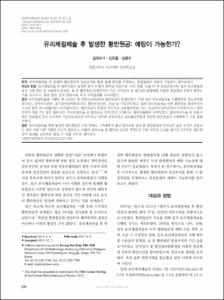유리체절제술 후 발생한 황반원공: 예방이 가능한가?
- Keimyung Author(s)
- Kim, Yu Cheol; Kim, Kwang Soo
- Department
- Dept. of Ophthalmology (안과학)
- Journal Title
- 대한안과학회지
- Issued Date
- 2014
- Volume
- 55
- Issue
- 2
- Abstract
- Purpose: To evaluate the causes of secondary macular hole after vitrectomy and the possibility of their prevention.
Methods: 27 patients (28 eyes) who experienced macular hole formation after vitrectomy were reviewed retrospectively. Age, sex, operation methods, duration between the vitrectomy and the secondary macular hole surgery and causes of the primary vitrectomy were recorded. Best-corrected visual acuity (BCVA) before and after primary vitrectomy; preoperative and postoperative macular findings with optical coherence tomography and fundus examination; and BCVA before and after macular hole surgery were analyzed.
Results: Of the 2945 eyes that had undergone vitrectomy, 28 eyes (0.96%) experienced macular hole formation. As causes of primary vitrectomy, 12 eyes had proliferative diabetic retinopathy, 6 eyes had rhegmatogenous retinal detachment, 2 eyes had branch retinal vein occlusion, 3 eyes had age-related macular degeneration and 5 eyes had trauma such as eyeball rupture or intraocular foreign body. The mean duration between primary vitrectomy and macular hole formation was 20.4 months (4 days-115 months). The estimated causes of macular hole formation included cystoid macular edema (CME) (n = 13), thinning of the macula (n = 6), thickening of internal limiting membrane or recurrence of preretinal membrane (PRM) (n = 7), recurrence of subretinal hemorrhage (n = 1) and macular damage during vitrectomy (n = 2). Final BCVA after macular hole surgery decreased in most cases compared to BCVA before macular hole formation except in 7 eyes (25%).
Conclusions: Close observation of the macula after primary vitrectomy especially in eyes with continuous CME, and recurrent PRM and proper management on them including timely removal of the tangential traction force are necessary for preventing macular hole formation. In addition, surgeons should make efforts not to exert excessive tractional force on the macula to avoid iatrogenic damage during removal of the preretinal membrane.
목적: 유리체절제술 후 발생한 황반원공의 임상분석을 통해 발생 원인을 추정하고, 원공발생의 예방이 가능한지 알아보았다.
대상과 방법: 유리체절제술 후 황반원공이 발생한 환자 27명의 28안을 대상으로 나이, 성별, 수술 전 후 최대교정시력, 일차 유리체절제술의 시행 원인 및 시술중의 문제점, 술 후 황반원공 발생까지의 기간, 안저검사 및 빛간섭단층촬영을 이용한 원공형성 전후의 황반소견을 조사하고, 원공 형성 전과 원공수술 후의 시력결과를 비교하였다.
결과: 유리체절제술을 시행한 총 2,945안 중 28안(0.96%)에서 황반원공이 발생하였다. 이중 일차 유리체절제술 시행원인은 당뇨망막병증(12안), 망막박리(6안), 분지망막정맥폐쇄(2안), 황반변성(3안), 외상 및 기타(3안)였고, 일차 유리체절제술 이후 황반원공 발생까지의 기간은 평균 20.4개월(4일-115개월)이었다. 황반원공의 추정된 원인으로 낭포황반부종 12안, 내경계막/망막전막이 두꺼워지거나 망막 전막의 재발 7안, 얇은 황반 6안, 유리체절제술 중 황반손상 2안이었고 1안에서는 황반하출혈이 관련있었다. 황반원공수술 후 최종시력은 원공형성 전과 비교하여 7안(25%)에서만 유지되고 대부분 감퇴하였고 낭포황반부종과 관련된 황반원공의 시력예후가 가장 불량하였다.
결론: 유리체절제술 후에 발생한 황반원공은 치료 후에도 시력예후가 좋지 않으므로 경과 중 원공발생과 연관성이 높은 소견이 관찰되는 경우 이에 대한 적절한 처치가 필요하고, 아울러 일차수술 중 황반에 과도한 견인으로 인한 의인성 손상을 줄이면 이차적인 황반원공의 발생을 상당부분 줄일 수 있을 것으로 생각한다.
- Alternative Title
- Macular Hole Formation after Vitrectomy: Preventable?
- Publisher
- School of Medicine
- Citation
- 김리브가 et al. (2014). 유리체절제술 후 발생한 황반원공: 예방이 가능한가? 대한안과학회지, 55(2), 230–236. doi: 10.3341/jkos.2014.55.2.230
- Type
- Article
- ISSN
- 0378-6471
- Appears in Collections:
- 1. School of Medicine (의과대학) > Dept. of Ophthalmology (안과학)
- 파일 목록
-
-
Download
 oak-bbb-02667.pdf
기타 데이터 / 3.33 MB / Adobe PDF
oak-bbb-02667.pdf
기타 데이터 / 3.33 MB / Adobe PDF
-
Items in Repository are protected by copyright, with all rights reserved, unless otherwise indicated.